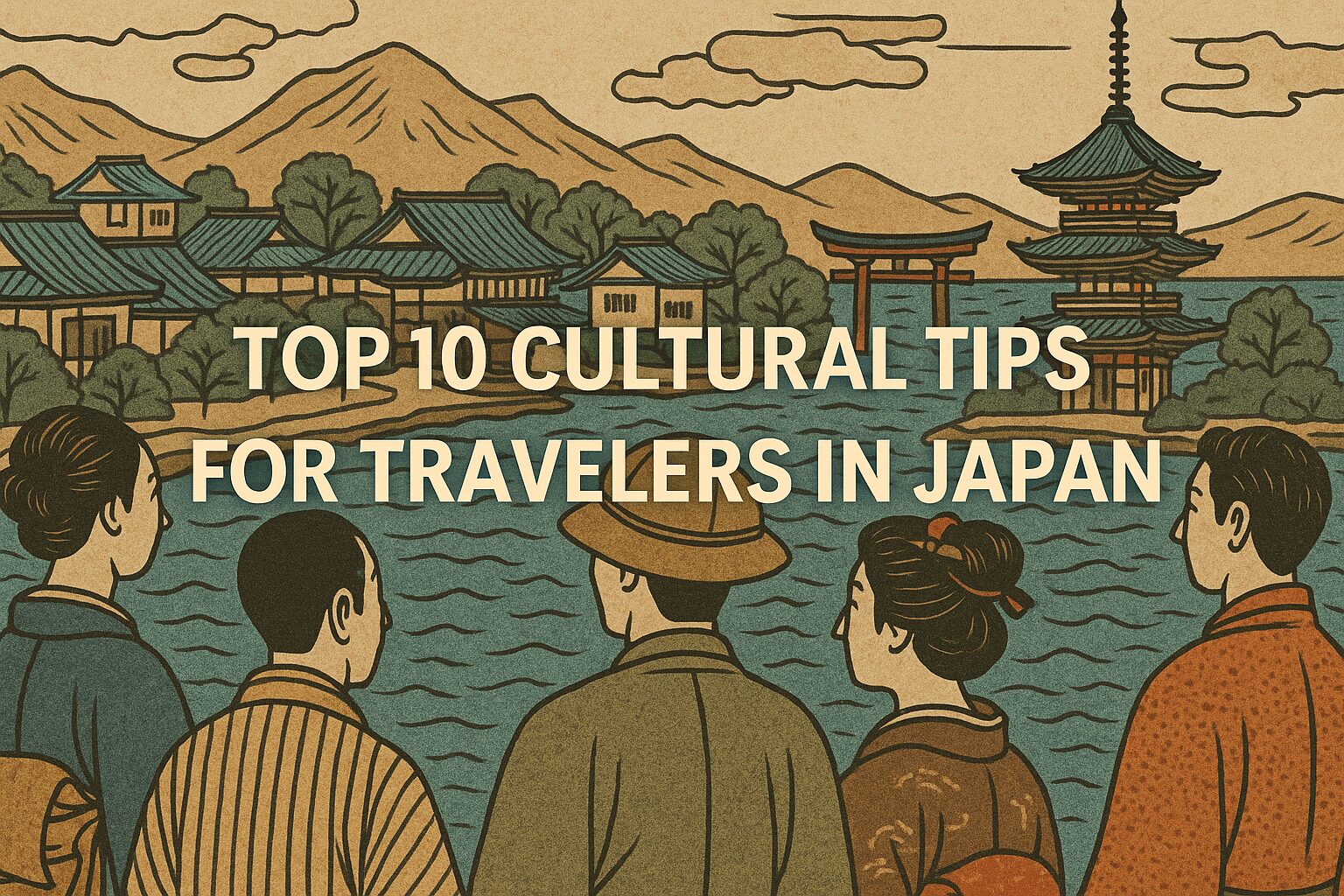- Introduction – Why Cultural Tips Matter in Japan
- 1. Respect Train Manners in Japan
- 2. Master Chopstick Etiquette
- 3. Learn Dining Etiquette – Do’s and Don’ts
- 4. Visiting Shrines and Temples
- 5. Public Bath (Onsen & Sento) Etiquette
- 6. Handling Money and Payments
- 7. Mind Your Space – Crowds and Queues
- 8. Polite Communication
- 9. Cultural Sensitivity – Do’s and Don’ts
- 10. Festivals and Seasonal Customs
- Conclusion – Travel Smoothly by Respecting Culture
Introduction – Why Cultural Tips Matter in Japan
Traveling in Japan is exciting: neon-lit cities, ancient temples, mouthwatering food, and some of the world’s most punctual trains. But behind the modern convenience lies a culture built on respect, harmony, and centuries-old traditions. For visitors, this can sometimes be confusing. Should you bow? Can you talk on trains? Is tipping rude?
Understanding basic cultural tips doesn’t just help you avoid awkward moments—it enhances your experience. By blending in with Japanese customs, you’ll not only enjoy smoother travels but also connect more deeply with locals. This guide covers ten essential cultural tips every traveler should know, mixing history, practical advice, and useful Japanese phrases.
1. Respect Train Manners in Japan
Quiet, Clean, and Efficient: Japan’s Rail Culture
Japan’s trains are famous for punctuality and cleanliness. But just as important is the atmosphere: quiet and orderly. For commuters, trains are not a place to socialize—they’re for rest or reading.
Key point: Silence is golden.
Essential Train Rules
- No phone calls: Keep your phone on silent (called manner mode). Messaging is fine, but don’t talk on the phone.
- Keep voices low: Conversations should be quiet, almost whispered.
- Priority seats: Reserved for the elderly, disabled, pregnant women, or parents with small children. Even if empty, avoid sitting there unless needed.
- Eating and drinking: Fine on long-distance trains (like the Shinkansen), but not on local commuter trains.
- Mind your backpack: Wear it in front of you or place it on the rack to avoid bumping others.
Useful Phrase
「すみません、降ります」 (Sumimasen, orimasu) – “Excuse me, I’m getting off.”
👉 Internal link idea: Link to your Suica & PASMO guide.
2. Master Chopstick Etiquette
Chopsticks (hashi) are used at almost every meal. While they may seem simple, misuse can offend.
Do’s
- Use the chopstick rest (hashi-oki) if provided.
- Pick food up gently, without stabbing.
Don’ts
- Don’t stick chopsticks upright in rice (resembles a funeral ritual).
- Don’t pass food chopstick-to-chopstick (resembles a cremation ritual).
- Don’t wave or point with chopsticks.
Useful Phrase
「いただきます」 (Itadakimasu) – said before eating.
「ごちそうさまでした」 (Gochisousama deshita) – said after eating.
3. Learn Dining Etiquette – Do’s and Don’ts
Japanese meals are full of small rituals:
- Wait to start: Don’t begin eating until everyone has their food.
- Pour for others: At izakaya (pubs), refill your friend’s glass before your own.
- Slurping noodles: It’s polite, not rude! It shows you’re enjoying the meal.
- Don’t tip: Service is included in the price. Leaving coins may confuse or insult staff.
4. Visiting Shrines and Temples
The Rituals
At a shrine (Shinto):
- Purify hands and mouth at the water basin (temizuya).
- Bow twice, clap twice, pray silently, bow once more.
At a temple (Buddhist):
- Simply put your hands together in prayer, no clapping.
Respectful Behavior
- Don’t take photos where prohibited.
- Dress modestly.
- Walk on the sides of shrine paths—the center is for deities.
👉 External link idea: Senso-ji Official Website
👉 Internal link idea: Link to What is Goshuin?
5. Public Bath (Onsen & Sento) Etiquette
Japan’s hot springs (onsen) are relaxing but intimidating for first-timers.
Key Rules
- Wash thoroughly before entering.
- No swimsuits allowed.
- Tattoos may be restricted—check in advance.
- Keep voices low; it’s a place for calm, not play.
Useful Phrase
「お風呂はどこですか?」 (Ofuro wa doko desu ka?) – “Where is the bath?”
👉 Internal link idea: Link to Onsen Etiquette Guide.
6. Handling Money and Payments
Japan is moving toward cashless, but cash is still widely used.
- Hand money with both hands, preferably in the tray provided.
- Avoid tossing coins or bills directly.
- IC cards (Suica, PASMO) and apps (PayPay) are increasingly common.
👉 Internal link idea: Link to How to Pay in Japan.
7. Mind Your Space – Crowds and Queues
- Stand in orderly lines, especially at train stations.
- Don’t cut queues—it’s a big no-no.
- In escalators: stand on the left in Tokyo, right in Osaka.
8. Polite Communication
Even with limited Japanese, politeness goes a long way.
Essential Phrases
- 「すみません」 (Sumimasen) – Excuse me / I’m sorry.
- 「ありがとうございます」 (Arigatou gozaimasu) – Thank you.
- 「お願いします」 (Onegaishimasu) – Please.
9. Cultural Sensitivity – Do’s and Don’ts
- Don’t point at people.
- Don’t eat while walking (except at festivals).
- Don’t blow your nose loudly in public.
- Do bow slightly when thanking or greeting.
10. Festivals and Seasonal Customs
Japan has thousands of festivals (matsuri).
- Participate respectfully—join in dances, but follow locals’ lead.
- Don’t block procession routes for photos.
- Try festival food stalls (yakisoba, takoyaki, taiyaki).
👉 External link idea: Japan Guide – Festivals
Conclusion – Travel Smoothly by Respecting Culture
By following these cultural tips, your trip to Japan becomes smoother and more meaningful. Respecting quiet trains, knowing how to eat politely, or offering a small bow creates positive connections with locals.
Japan isn’t just about sightseeing—it’s about experiencing harmony between people and place. Respect opens doors, and a little effort goes a long way.
👉 Related reading:
- [How to Use Suica & PASMO: The Ultimate Guide for Tourists in Japan]
- [Onsen Etiquette in Japan: A Beginner’s Guide]
- [What is Goshuin? The Japanese Temple and Shrine Stamp Book Explained]



コメント